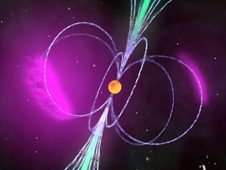Recently, NASA’s Fermi Gamma-ray Space Telescope discovered no more, no less than 12 pulsars, and it also detected gamma ray pulse from 18 others. These findings are forcing scientists to rethink what we know about dying stars, as they totally underestimated the power of these stellar cilinders.
“We know of 1,800 pulsars, but until Fermi we saw only little wisps of energy from all but a handful of them,” says Roger Romani of Stanford University, Calif. “Now, for dozens of pulsars, we’re seeing the actual power of these machines.”
 Pulsars are rotating neutron stars, highly magnetized, that emit a beam of electromagnetic radiation with a period of the pulse variating from 8.5 seconds to just 1.5 miliseconds. They are what remains when a massive star explodes. They’re also incredible cosmic dynamos and despite the fact that scientists don’t fully understand this process, they can say for sure that very intense electric and magnetic fields spin and accelerate particles to speeds very close to that of light.
Pulsars are rotating neutron stars, highly magnetized, that emit a beam of electromagnetic radiation with a period of the pulse variating from 8.5 seconds to just 1.5 miliseconds. They are what remains when a massive star explodes. They’re also incredible cosmic dynamos and despite the fact that scientists don’t fully understand this process, they can say for sure that very intense electric and magnetic fields spin and accelerate particles to speeds very close to that of light.
Most pulsars were found because they emitted pulses at radio wavelength which are emitted from the pulsar’s poles. If these poles and the star’s spin axis are not alligned exactly, then the beams would be swept across the sky, meaning that we can detect them only if such a beam meats a radio telescope. But data is often inaccurate or biased because these telescopes are situated on Earth
“That has colored our understanding of neutron stars for 40 years,” Romani says. The radio beams are easy to detect, but they represent only a few parts per million of a pulsar’s total power. Its gamma rays, on the other hand, account for 10 percent or more. “For the first time, Fermi is giving us an independent look at what heavy stars do. “
“We used to think the gamma rays emerged near the neutron star’s surface from the polar cap, where the radio beams form,” addsAlice Harding of NASA’s Goddard Space Flight Center in Greenbelt, Md. “The new gamma-ray-only pulsars put that idea to rest.”
Now, scientists have their hands full with this new class of gamma-ray pulsars, which they believe arise far above the neutron star. Due to the fact that rotation powers their emissions they tend to slow down a bit as they “age”; however, Fermi picked up emissions from gamma rays from seven millisecond pulsars (which are called this way because they spin somewhere between 100 and 1000 times a second!!!). They tend to sometimes “break the rules”, and “cohabitate” with a normal star, residing in binary systems.
Here are some animations to give you a better and more visual understanding of this.
Quick Time animation
Credit: NASA/Fermi/Cruz deWilde

These gamma-ray pulsars show that gamma rays must form in a broader region than believed previously. Here, you can see the radio beams (green) never intersect Earth, but the pulsed gamma rays (magenta) do.
Animation 2
Credit: NASA/Goddard Space Flight Center Conceptual Image Lab

But gamma ray pulsars are no longer lighthouses, as pointed out here.
Animation 3
Credit: NASA/Dana Berry

Isolated pulsars slowly slow down their spin, but if a pulsar “lives” in a binary system with a normal star, it actually goes faster and faster. As a result, you could have a pulsar that spins in just a few miliseconds. How fast can they go?? It’s still uncertain.








